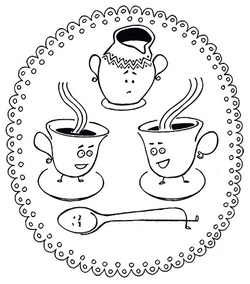
The Café Method is a dialogue method that encourages people to take part in discussions on current topics in informal and comfortable surroundings.
The room is furnished as invitingly as possible, e.g. as a café where you are seated around small tables. The process is led by the moderator of the meeting. The meeting should start with a short account of the facts of the matter. Information materials should also be at hand for the participants. Small dialogue groups around the tables examine a theme or given problems, that should be open and challenging. The participants switch tables/groups at certain times during the meeting. In essence, the process is carried out in three stages: analysis, in-depth analysis, proposal preparation. The work at the tables is documented. Ideas and views are passed on to the other participants during or at the end of the meeting. There are plain rules/principles to aid involvement and creativity among the participants. The leader of the process should have a short education in the method. The furnishing of the room is important. Questions and topics must be relevant and clear. Costs may vary – if the premises are an actual café with just about ten participants the cost may be very modest. For large events with hundreds of participants in a special location, the costs could quickly increase. Since the method does not require a large number of process leaders, it could be an inexpensive way of holding creative meetings.
The room is furnished as invitingly as possible, e.g. as a café where you are seated around small tables. The process is led by the moderator of the meeting. The meeting should start with a short account of the facts of the matter. Information materials should also be at hand for the participants. Small dialogue groups around the tables examine a theme or given problems, that should be open and challenging. The participants switch tables/groups at certain times during the meeting. In essence, the process is carried out in three stages: analysis, in-depth analysis, proposal preparation. The work at the tables is documented. Ideas and views are passed on to the other participants during or at the end of the meeting. There are plain rules/principles to aid involvement and creativity among the participants. The leader of the process should have a short education in the method. The furnishing of the room is important. Questions and topics must be relevant and clear. Costs may vary – if the premises are an actual café with just about ten participants the cost may be very modest. For large events with hundreds of participants in a special location, the costs could quickly increase. Since the method does not require a large number of process leaders, it could be an inexpensive way of holding creative meetings.
 RSS Feed
RSS Feed
